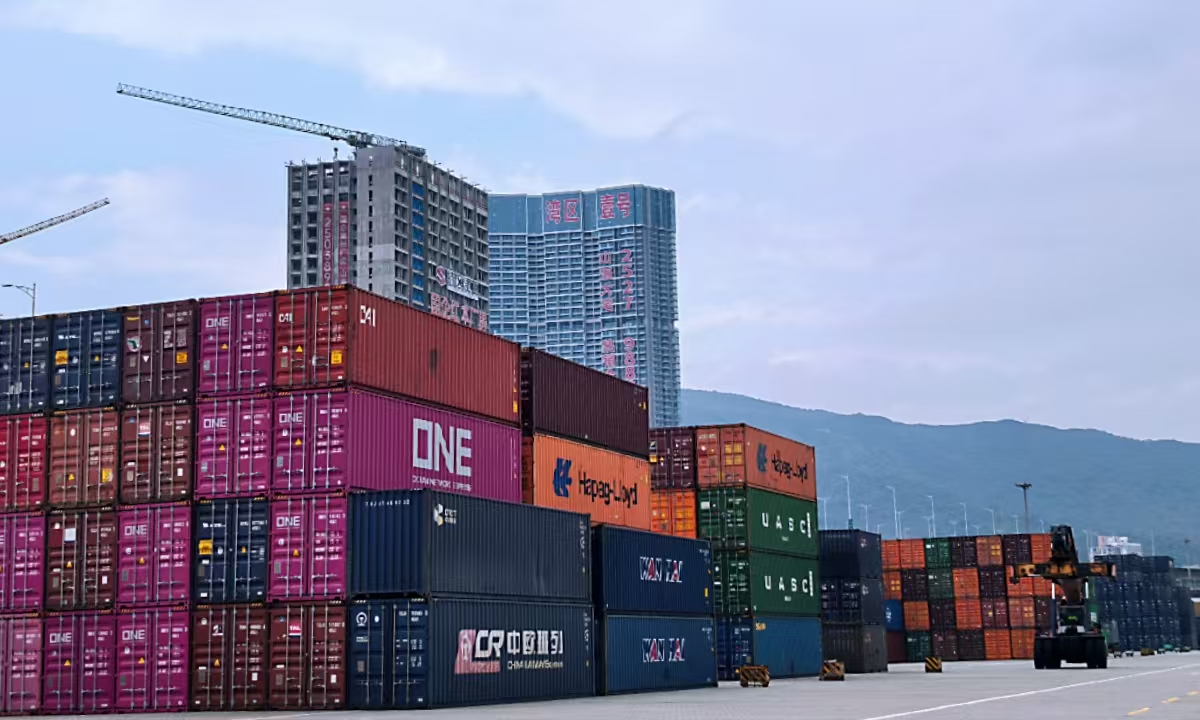110 TEUs Brazilian frozen juice embarks journey to Chinese New Year tables

Various goods are being transported in and out of Yantian Port in Shenzhen, South China’s Guangdong Province on January 22. (Zhang Yiyi/GT)
The final batch of frozen orange juice from Brazil before the Chinese New Year was transported by train from Shenzhen's Yantian Port in South China's Guangdong Province on Wednesday, heading to Ganzhou, East China's Jiangxi Province for processing, the Global Times observed at Yantian Port.
The final batch of Brazilian orange juice for the Spring Festival arrived in China on Tuesday. Since November, 110 Twenty-Foot Equivalent Units (TEUs) have been shipped from São Paulo to Yantian Port and then transported to Ganzhou for processing, adding exotic flavors to Chinese tables, a supplier representative told the Global Times.
The representative told the Global Times, "China is a key market for Brazil. Rail transport, introduced in 2023, is more punctual and has lower loss rates than previous road distribution."
Located in the tropics, Brazil's abundant sunshine, ample rainfall, and fertile soil make it ideal for growing citrus fruits. In recent years, Brazilian juice has entered the Chinese market through cold-chain logistics and has been well-received. The export is increasing steadily in recent years and more trade cooperation is expected between the two countries, according to the representative.
Each successful "juice deal" between the two countries relies on China's advanced transport infrastructure. "China's unique rail-sea intermodal service streamlines processes and saves time, cutting over 100,000 yuan ($13,600) in costs for the company during the Spring Festival period transportation," the representative said.
"The Yantian-Ganzhou railway route spans over 500 kilometers and takes 10 hours. Our company's cold-chain transport ensures high stability, maintaining a constant -18°C with minimal temperature fluctuations, preserving the juice's freshness and flavor," Li Jin, deputy director of the cold-chain logistics department at China Railway Special Cargo Logistics Co told the Global Times on Wednesday.
"Foreign clients care deeply about carbon standards. Our rail-sea transport meets international low-carbon requirements and excels in green logistics," Li said.
The Global Times learned that after the train carrying frozen juice from Brazil arrived at Yantian Port via sea, workers directly transferred the refrigerated containers from the ship to the train. "The shipment was transported to Ganzhou without transshipment, ensuring seamless end-to-end logistics services, including port handling, warehousing, and distribution," Li said.
The success of Brazilian frozen juice business reflects a win-win between producers and consumers and showcases the deep integration of global supply chains with China's consumer market, market observers said.

Containers loaded with frozen juice from Brazil are being charged at Yantian Port in Shenzhen, South China's Guangdong Province, on January 22. (Zhang Yiyi/GT)
Besides the orange juice, New Zealand kiwifruit, Spanish persimmons, Chilean cherries, and a growing array of premium overseas fruits are bringing vibrant flavors to Chinese consumers for the celebration of the Chinese New Year.
New Zealand's Zespri kiwifruit exports to China have seen a big boost in 2024, with sales up by 40 percent compared to the previous year. The Chinese market has again secured its position as the world's largest, accounting for 25 percent of global kiwifruit sales, Michael Jiang, President of Zespri Greater China, told the Global Times on January 17.
From January to November 2024, the total value of fresh cherries imported from Chile exceeded $2.8 billion, representing a 26 percent year-on-year increase, the China Chamber of Commerce of Import & Export of Foodstuffs, Native Produce & Animal By-Products (CFNA) told the Global Times.
Photos
Related Stories
- Brazilian mining giant Vale tests largest ore carrier refitted by a Chinese shipyard for green transformation
- Stories of China's major-country diplomacy: Brazil and China enjoy strong friendship despite being geographically far apart
- Chinese FM holds phone talk with special advisor to Brazilian president on ties
- A bridge between China and Brazil: Young Brazilian businessman adds brilliance to China-Brazil friendship
- Brazilian envoy hails growing ties with China
Copyright © 2025 People's Daily Online. All Rights Reserved.









